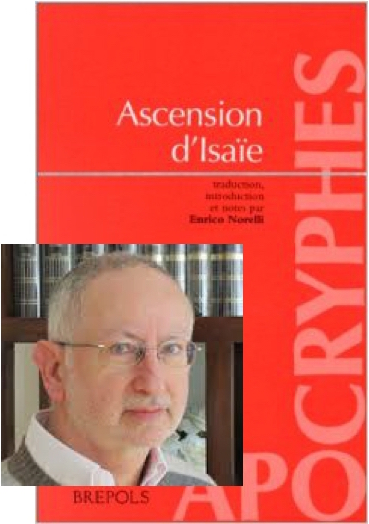
Earl Doherty and Richard Carrier have suggested that there is an ancient text outside the Bible that stands as direct evidence for some early Christians believing Asc. Isa.), believed to be a composite document whose earliest parts were quite likely authored as early as the late first century.
Scholarly work on Asc. Isa. has been on the move. 1995 saw two pivotal Italian works that have paved the way for a new consensus. Enrico Norelli has been a key player in this research.
- Ascensio Isaiae: Textus, ed. P. Bettiolo, A. Giambelluca Kossova, E. Norelli, and L. Perrone (CCSA, 7; Turnhout, 1995);
- E. Norelli, Ascensio Isaiae: Commentarius (CCSA, 8; Turnhout, 1995).
These were both included in volumes 7 and 8 of the Corpus Christianorum Series Apocryphorum in 1995.
I don’t have access to those but yesterday a copy of Norelli’s 1993 Ascension du prophète Isaïe arrived in the mail.
I have only struggled through chapter 2 with my very rusty French so far but it is already clear that the old views are being challenged.
Here are the highlights:
- The work is not nearly so fragmented as earlier studies have believed. Both the first part, chapters 1 to 5, depicting the martyrdom of Isaiah, and the second part, chapters 6 to 11, portraying Isaiah’s vision of the descent of the Christ figure (the Beloved) down through the seven heavens to be crucified, harrow hell and return to sit beside God again, are Christian works.
- The Christian sect responsible for the Asc. Isa. (all of it) was exalted revelations through visions and saw themselves competing with rival sects, each blaming and persecuting the other as false prophets.
- The account of the birth of the Beloved to Mary in Bethlehem is not a late addition but was original to the vision chapters (6-11). That means The Beloved did indeed descend to earth and was crucified on earth — unrecognized by the demons.
- The details of the nativity scene draw on a source also known to the evangelist responsible for the Gospel of Matthew. The Asc. Isa. does not know the canonical gospel but both are using a common source. The two nativity versions — Matthew’s and the Asc. Isa.‘s — represent competing theologies. That is, the Asc. Isa. was (and several reasons are given for this conclusion) written around the same time or environment that produced the Gospel of Matthew.
- The reason for the Beloved appearing to be flesh and dying was to save humanity by means of conquering their demonic rulers.
To me this is fairly mind-blowing stuff if true. We would need to account for a view of the “gospel” that stood in stark contrast to all the assumptions and “traditions” behind Matthew appearing on the scene at around the same time. That question alone poses enormous questions for the traditional view of gospel origins, surely.
Further, if we accept Norelli’s revisions to our understanding of the Asc. Isa. then it would appear that the Asc. Isa. might support in part Roger Parvus’s interpretation of the original (“mythicist”) gospel: that Jesus descended to earth to be crucified before ascending again. Except that Roger, I think, argued for Christ only appearing for a short time on earth for this purpose. The Asc. Isa. has the Beloved hiding his identity from the demons by means of slipping into the world through Mary.
Okay, my head is still spinning. Keep in mind that the above is my impression as discerned through some very fuzzy memories of my French. I would like to roughly paraphrase (not translate!) the different sections of chapter 2 to share with others here over the coming weeks.
Meanwhile, here is a diagram I prepared for an older post of mine (before I had a copy of Norelli’s book) that shows something of the complexities of the history of interpretations of the Asc. Isa.: Continue reading “A New (Completely Revised) Look at the Ascension of Isaiah”
